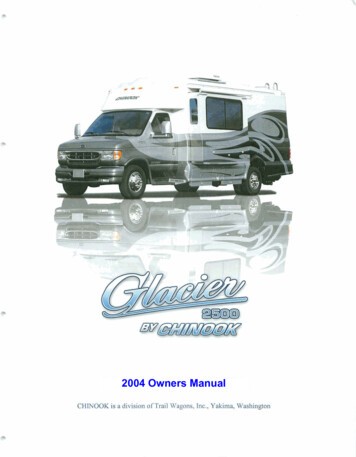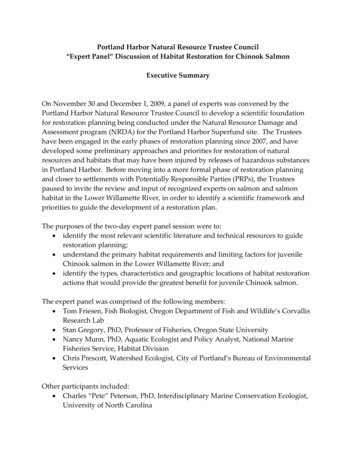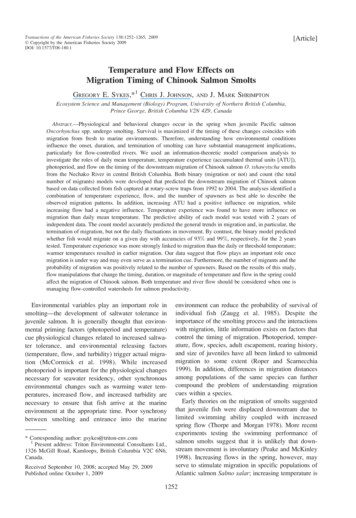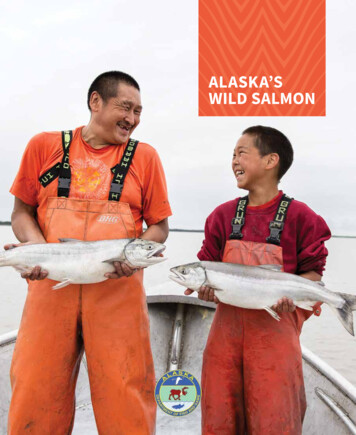
Transcription
Impact of Pinnipeds onChinook SalmonNate Pamplin, Dr. Scott Pearson, andDr. Joe Anderson
AcknowledgmentsCollaboration and research Ben Nelson Steve Jeffries Nisqually Indian Tribe Squaxin Island Tribe Austen Thomas Bill Walker Monique Lance The countless WDFW and tribalbiologists responsible for salmonpopulation monitoring WDFW biologists and techniciansresponsible for pinnipedmonitoringFunding Long Live the Kings and SalishSea Marine Survival Project Washington State General Fund Dingell-Johnson SportfishRestoration Act Funds U.S. Navy Salmon Recovery Funding Board WRIA 8 & 9 CooperativeWatershed Management Grantprogram U.S. Army Corps Engineers Tacoma Water Seattle Public Utilities andSeattle City Light2
Questions What are the primary salmon-eating pinnipeds in Washington? Where are they located? How many are there? And what are theirpopulation trends? What do they eat? How many juvenile Chinook do harbor seals consume? How many adult Chinook equivalents does this rate of juvenileconsumption represent? What level of seal removal is needed to achieve meaningful increases inadult Chinook return rates? What other information do we need? What administrative options are there to reduce pinniped predation?3
Complex Food WebSource: Strait of Georgia ecosystem model – D. Preikshot & I. Perry,Fisheries and Oceans Canada4
Major Declines in Natural Origin ChinookSource: Puget Sound Salmon Recovery Plan5
Chinook Important to Orca DietSource: Center for WhaleResearch6
Southern Resident Orca Trends7
Predation is One of Many FactorsAffecting Salmon Recovery Hydropower Hatcheries Habitat Disease and parasites Contaminants Predation8
Chasco et al., 2016 Puget Sound bioenergetics model Estimated consumption of Chinook salmonfrom 1970-2015 Modeled population size, diet, and energeticdemands for killer whales, California sealions, Steller sea lions, and harbor seals Chinook consumed by pinnipeds increasedfrom 68 to 625 metric tons Pinnipeds consumed more than killer whalesand all fisheries9
How Does Our Work Differ from Chasco? Use recent seal population estimates New seal diet information from Puget Sound Similar modelling approach but we account forsources of uncertainty not included in the“Chasco” model Express smolt consumption as fraction of totalabundance Examine sensitivity to assumptions of marinesurvival after encountering seals10
Questions What are the primary salmon eating pinnipeds in Washington? Where are they located? How many are there? And what are theirpopulation trends? What do they eat? How many juvenile Chinook do harbor seals consume? How many adult Chinook equivalents does this rate of juvenileconsumption represent? What level of seal removal is needed to achieve meaningful increases inadult Chinook return rates? What other information do we need? What administrative options are there to reduce pinniped predation?11
Focus on Three Species of Pinnipeds Harbor Seal California Sea Lion Steller Sea Lion12
California Sea Lion Primarily present in Washingtonwaters in Sept - April A single US stock13
Source: Laake et al. 201814
Steller Sea Lion Primarily present in Washingtonwaters between Sept. and April Washington’s Stellers belong to theeastern distinct population segment which ranges along the west coastof North America from SoutheastAlaska to central California This segment was delisted underthe ESA15
Source: Wiles 2014 WDFW StatusReview16
Harbor Seal Year-round resident 1 coastal stock and threestocks in the inland marinewaters Washington/Oregon coast Northern inland waters Hood Canal South Puget 9-17,896)1,300(1,059-1,542)17
Harbor Seal Year-round resident 1 coastal stock and threestocks in the inland marinewaters Washington/Oregon coast Northern inland waters Hood Canal South Puget 9-17,896)1,300(1,059-1,542)Key assumptions: 1) Correction factor from Huber et al. 2001 isreflective of haulout patterns observed today, and 2) The 2013seal population estimate is similar to today’s population size18
Puget Sound4,0001,000800600400Hood Canal20001970Harbor Seal r Seal CountHarbor Seal Count1,400Strait of Juan de ear2010202019
1,0008006003,500400Hood Canal20001970Harbor Seal r Seal CountHarbor Seal Count1,400Strait of Juan de FucaPuget SoundConclusions:1) Uncertain trend in Hood Canal,2) Different dynamics in the Puget Sound, Strait ofJuan de Fuca and Hood Canal 00Year2010202020
Questions What are the primary salmon eating pinnipeds in Washington? Where are they located? How many are there? And what are theirpopulation trends? What do they eat? How many juvenile Chinook do harbor seals consume? How many adult Chinook equivalents does this rate of juvenileconsumption represent? What level of seal removal is needed to achieve meaningful increases inadult Chinook return rates? What other information do we need? What administrative options are there to reduce pinniped predation?21
We Focus on Juvenile ChinookConsumption by Harbor SealsSource:Chasco 2016 CJFAS22
What a Scat Represents Prey from previous foraging bouts/meals 1 “meal” occurs in 3.8 1.8 scats (range 1–10) Passed over 24-48 hours Contain digested/degraded hard parts and DNA23
Puget Sound Sampling in 2016 North Sound: WesternWashington University South Sound: WDFW 1,129 total samples Collected Jan-Aug24
Diet Reconstruction Allows identification of different species in the feces Percent diet by species Distinguishes adults vs. juvenilesThomas et al. 201725
Results 57 different prey species 53 species of fish 1 unknown crustacean 3 species of cephalopods (Pacific red octopus, giant Pacificoctopus, California market squid) 5 salmonid species (Chinook, chum, coho, cutthroat trout,steelhead)26
Winter DietJanFebMarch27
Spring-Summer DietAprilMayJuneJuly-Aug28
Key Findings Highly diverse diet (57 prey species) Highly variable diet in space and time Presenting estimates from a single year (2016) Considerable uncertainty associated with estimates Chinook salmon represent 1-2% of seal diet duringFebruary - August29
For juvenile Chinook, why are we worriedabout small diet percentages?30
Why are we worried about small diet percentages?Seal daily needs (kg)Diet proportion juv ChinookMass of juv Chinook/day/seal (kg)2.01%0.02Range: 1.9-2.1kg95% CI: 0.2-2.4%Mass/juv Chinook (kg)Avg. # juv Chinook/day/seal0.0082.595% CI: 0.005-0.011kg19,00047,5001,425,00095% CI: 15,458-22,542# SealsJuv Chinook eaten per dayJuvenile Chinook eaten per month95% CI: 518,000-2,418,00031
Seals consumed between 5.2 and 26.8million juvenile Chinook in 2016(median 12.2 million)We don’t know if 2016 is representativeof harbor seal annual dietEstimated total Chinook smolts consumed by Harbor Sealsin 2016 (millions)32
Questions What are the primary salmon eating pinnipeds in Washington? Where are they located? How many are there? And what are theirpopulation trends? What do they eat? How many juvenile Chinook do harbor seals consume? How many adult Chinook equivalents does this rate of juvenileconsumption represent? What level of seal removal is needed to achieve meaningful increases inadult Chinook return rates? What other information do we need? What administrative options are there to reduce pinniped predation?33
Impacts to Salmon mentSmoltsFryEggsFreshwater &estuarine habitatSpawners34
Smolt ConsumptionPercent smolts consumed Estimated number consumedTotal hatchery smoltsRegional Mark InformationSystem release database Total natural smoltsRotary screw trap data35
Smolt ConsumptionPercent smolts consumed 12.2 million (5.2 – 26.8 million)41.6 million hatcheryRegional Mark InformationSystem release database 4.5 million naturalRotary screw trap data36
Smolt Consumption 41.6 million hatchery 4.5 million naturalPercent of distributionPercent smolts consumed12.2 million (5.2 – 26.8 million)Estimated percent smolts consumed by seals37
Comparison to Survivalsmolt to adult return (SAR) returning adultstotal smoltsNaturally producedHatcheryWatershedOcean entry yearsStockOcean entry yearsStockOcean entry yearsSkagit1994 – 2011Nooksack springs2001 – 2011Gorst fall2002 – 04; 09 – 11Cedar2003 – 2011Samish fall2001 – 2011Nisqually fall2001 – 2011Bear2003 – 2011Skagit spring2001 – 2011Minter fall2003 – 2005Green2003 – 2012Skykomish summer 2001 – 2011Tumwater fall2001 – 2005Nisqually2009 – 2010Issaquah fall2003 – 2007Hoodsport fall2003 – 2011Dungeness2005 – 2012Green fall2001 – 2011Skokomish fall2001 – 2011Puyallup fall2003 – 2008; 2010Data Source: WDFW smolt monitoringData Source: Gary Marston (WDFW), from RMIS CWT database38
Comparison to SurvivalEstimated seal consumptionNaturally produced survivors (SAR)N 58 estimatesHatchery survivors (SAR)N 111 estimatesPercent of smolts39
Salmon Marine Survival ScheduleNumber of salmonsmoltsadultsTime40
Salmon Marine Survival ScheduleNumber of salmonsmoltsadultsTime41
Compensatory MortalitysmoltsNumber of salmonseal consumptionadultsTime42
Compensatory MortalitysmoltsCurrent scenarioNumber of salmonLess seal consumptionno compensatory mortalityLess seal consumption100% compensatory mortalityadultsTime43
Adult EquivalentsGoalExpress estimated consumption of smolts by seals in terms of adultsKey assumptions1. Age specific marine survival and maturity schedules of salmonafter seal consumption2. Seals consume salmon smolts first, before any other predatorsor other sources of salmon mortality3. Levels of compensatory mortality following seal predation44
Adult EquivalentsAssumed marine survival after seal consumptionTotal adult return predicted from 46.1 M smoltsLowerHigher232,000464,0000.5 %1.0 %No compensatory mortality84,000 (36,000 – 183,000)167,000 (71,000 – 367,000)50% compensatory mortality42,000 (18,000 – 92,000)84,000 (36,000 – 183,000)100% compensatory mortality00Adult abundanceSmolt to adult return rate (SAR)Adult equivalents of smolts consumed by seals45
Questions What are the primary salmon eating pinnipeds in Washington? Where are they located? How many are there? And what are theirpopulation trends? What do they eat? How many juvenile Chinook do harbor seals consume? How many adult Chinook equivalents does this rate of juvenileconsumption represent? What level of seal removal is needed to achieve meaningful increases inadult Chinook return rates? What other information do we need? What administrative options are there to reduce pinniped predation?46
Reduction in total juvenile Chinookconsumption by seals10%25%50%Target sealabundance17,13014,3009,500Initial removal1,8704,7009,500255530710Annual removals47
Questions What are the primary salmon eating pinnipeds in Washington? Where are they located? How many are there? And what are theirpopulation trends? What do they eat? How many juvenile Chinook do harbor seals consume? How many adult Chinook equivalents does this rate of juvenileconsumption represent? What level of seal removal is needed to achieve meaningful increases inadult Chinook return rates? What other information do we need? What administrative options are there to reduce pinniped predation?48
Information NeedsPinniped predation Better understanding of the window of time when juveniles areconsumed Better understanding of where seals forage on juvenile salmon Additional years of Harbor Seal population estimates to increaseconfidence in carrying capacity Additional years of seal diet from other locations to understand temporaland spatial variability in Seal diet Estimates of adult fish consumption Better diet information for California and Steller sea lions49
Information NeedsSalmon Survival Better understanding of smolt migratory survival, especially for hatchery-origin outmigrants Better understanding of the body size of salmon consumed, particularly predation onlarger resident Chinook (i.e., “Blackmouth”) Better understanding of the window of time when juveniles are consumedEcosystem and marine food web Impact of transient killer whales on harbor seals (and vice versa) Other sources of marine mortality on juvenile salmono Other salmon predators – timing and magnitude of consumptiono Linkage between seals and other salmon predators50
Questions What are the primary salmon eating pinnipeds in Washington? Where are they located? How many are there? And what are theirpopulation trends? What do they eat? How many juvenile Chinook do harbor seals consume? How many adult Chinook equivalents does this rate of juvenileconsumption represent? What level of seal removal is needed to achieve meaningful increases inadult Chinook return rates? What other information do we need? What administrative options are there to reduce pinniped predation?51
Marine Mammal Protection Act (MMPA)52
Goals of the MMPA To maintain species/stocks at their OptimumSustainable Population (OSP) and be a significantfunctional element in the ecosystem. To restore depleted stocks to OSP. To reduce bycatch and serious injury of marinemammals incidental to commercial fisheries toinsignificant levels approaching a zero mortalityrate.53
MMPA Section 101 Take Moratorium“There shall be a moratorium on the *taking* andimportation of marine mammals and marinemammal products ”*Take* is defined as “harass, hunt, capture or kill,or attempt to harass, hunt, capture or kill anymarine mammal.”Similar to language in the ESA.54
Management Options in the MMPA Apply for Waiver and Request Direct Take Request waiver of the Take Moratorium [Section 101(a)(3)] Rule-Making [Section 103] Take Permit [Section 104] Request Return of Management Authority to State Section 109 Pinniped Removal Authority Section 120 Intentional lethal taking of individually identifiablepinnipeds which are having a significant negative impact onthe decline/recovery of salmonids55
Waiver of Take Moratorium and Direct Take PermitMMPA Sections: Section 101(a)(3)(A)—Waiver on the Requirements to allow Take Section 103—Regulations on Taking of Marine Mammals Section 104—Permit authorizing TakeConsiderations: Rarely pursued ( 10 times since 1972) Extensive Public Process: Requires administrative law judge hearing,regulations, NEPA, consultation with Marine Mammal Commission Criteria: Stocks must be at OSP, best available science, population trends,ecosystem effects, technical feasibility, meet MMPA objectives, amongothers.56 No process timelines
Federal Transfer of MMPA ManagementAuthority to State (Section 109)Considerations: No successful transfer to date. Transfers management authority to state; Secretary enters co-op agreement withstate. State develops program consistent with MMPA May require RCWs Will require WACs Need to establish marine mammal program to implement regulatory activitiesconsistent wth MMPA More financial investment by the state Transfer authority for stocks at OSP. Consult with Marine Mammal Commission and Pacific Fisheries Management Council No NEPA; SEPA would apply; no process timelines in MMPA57
Pinniped Removal Authority (MMPA Section 120)Considerations: Allows intentional lethal taking of pinnipeds which are having asignificant negative impact on the recovery of salmonid fisherystocks which are:o Listed under ESAo Approaching ESA statuso Migrate through Ballard Locks, WA Permit for specific numbers, location, timing Pinniped stocks are not depleted or listed as strategic stock(s) Pinniped Fishery Interaction Task Force NEPA Individually identifiable animals58
Other Considerations Highly contentious proposal Extensive, untested, complicated processo Rarely pursuedo Exposure to legal challengeso Uncertain outcome of obtaining approvals NMFS unlikely has existing resources to process application Data uncertainty; complicated ecological system and food webo Not as “prescriptive” as what might be perceived bybioenergetics models summarized in this presentation.59
MMPA’s Potential Biological Removal The maximum number of animals, not including naturalmortalities, that may be removed from a marine mammalstock while allowing that stock to reach or maintain itsoptimum sustainable population. Function of:o Minimum population estimateo One-half the maximum theoretical or estimated netproductivity rate of the stock at a small population size.o A recovery factor between 0.1 and 1.060
NOAA Fisheries Stock Assessment ReportsSpecies/StockHarbor Seal – WA/ORCoast (2014)Harbor Seal- NorthernInland Waters (2014)Harbor Seals Southern Puget Sound(2014)Harbor Seals – HoodCanal (2014)PopulationEstimatePotential BiologicalRemoval (PBR)16,165N/A11,036N/A1,568N/A1,088N/A61
Potential Increase in the Number of Adult Chinookif Harbor Seals were Removed at PBR LevelPBR0%comp. mortN. Inland1,1625,500 (2,200-12,500)S. Sound88400 (150-950)300 (120-710)210 (80-470)Hood Canal139190 (70-420)140 (60-310)90 (40-210)1,2906,100 (2,400-13,800)4,600 (1,800-10,400) 3,100 (1,200-6,900)1,1005,000 (2,000-11,300)3,700 (1,500-8,500) 2,500 (1,000-5,600)RegionInland TotalCoast225%comp. mort.50%comp. mort.4,100 (1,600-9,300) 2,800 (1,100-6,200)1Theissue of which correction factor to use for Hood Canal needs to be resolved; this is atentative estimate using Huber’s correction factor.2For this exercise, the Washington coast was considered as its own stock. Ultimately, we willneed harbor seal estimates from Oregon to calculate PBR for this stock.62
SRKW Task Force Recommendation 12:Puget Sound/Outer Coast Pinnipeds Pilot project for removal/alteration of artificial haul out nearlocations with significant outmigration and predation ofChinook smolts. Complete ongoing research and coordinate an independentscience panel to review/evaluate extent of pinniped predation. Engage NOAA to determine OSP for harbor seals. Convenve co-management panel to coordinate with sciencepanel and assess appropriate management actions. Provide funding for these recommendations.63
2018 Public Comments Sent To Governor Inslee’sOrca Task Force Around Pinniped PredationDuring two public comment periods, 1,146 total comments on predation were tallied from 839 individualsTHEMES% OF TOTALSupport lethal removal of pinnipeds25.6%Do not support lethal removal of pinnipeds25.1%Predation of salmon by pinnipeds is not the primary issue for orcas17.4%Concern with interfering with ecological balance or doing single species management9.5%Support haul out removal and/or increasing forage fish to aid predation issues6.9%Not enough information available to support management of pinnipeds6.2%Predation issues need to be fixed while hatchery production is ramped up2.3%Concern around transient orca needs6.1%Support protection of pinnipeds0.9%64
Summary and Next Steps Important to consider the biological, administrative,logistical, and social aspects of this high-profile issue. Complex food web—we’ve modeled one aspect. While generalists, harbor seals collectively consume asignificant number of Chinook smolts. Ability to reduce pinniped predation impacts on returningadult Chinook is uncertain. MMPA administrative options are complex and limited. Worth pursuing further scientific collaboration and exploremitigating pinniped predation near estuaries of concern. Need to consider other pinniped impacts on adult Chinookand need to pilot artificial haul-out dissuasion.65
Questions66
Additional years of Harbor Seal population estimates to increase confidence in carrying capacity Additional years of seal diet from other locations to understand temporal and spatial variability in Seal diet Estimates of adult fish consumption Better diet information for California and Steller sea lions 49










